#women also love analysis through creative expression
Explore tagged Tumblr posts
Note
Have you seen this post?
ivyblooms (dot) tumblr (dot) com/post/742518636794839040/ormondhsacker-randsexual-scifigrl47
It’s theories why men don’t write fic, and it’s got such a libfem take at the end, essentially saying: “Fic is written by marginalized groups in order to see themselves in canon, so cishet white males don’t need to write fic because canon already caters to them”
The observation is correct (female fandom is more creative than male fandom) but they come up with the wrong explanation bc it’s only “cishet white males” they’re willing to dunk on.
Gay men and MoC aren’t represented in most mainstream media either, but they aren’t the ones writing 300k fics to resolve this. So the differences between male and female fandom can’t be explained by the need to “see oneself in canon”. Creative fandom and fic especially is a majority-female hobby. But female writers aren’t trying to “see themselves in canon” either bc all they ever write about is fictional men. I’d say that women ACTUALLY write out of intense and often romantic passion for the (usually male) characters, which compels women to generate endless fanworks to satisfy their romantic ideals and numb the pain of their dull realities. Men also have dull realities, yet the fandom divide is purely male/female and the reason is money vs passion.
Women’s passion for fictional escape is so great that they’ll write a 300k fic saga for free if they have to. Do you honestly think any man capable of producing 300k words of creative writing would share it FOR FREE? No, he would try to publish it as an original novel to make money off his labor. Men aren’t socially conditioned to perform free labor like women. Women are conditioned to generate free resources for others while men hoard resources, only giving them away if something of equal or greater value is promised in return. That’s why YouTube (monetization) is male-dominated and they will never touch Ao3, because it’s illegal to make money off fic. It’s the one female-only space men aren’t interested in.
Men live by the motto “If you’re good at something never do it for free.” Whatever passion and creativity men possess comes second to their need for material reward. Women dominate fandom bc we value love and connection more than squeezing money out of every opportunity.
i don't even have anything to add to this bc i think you hit the nail on the head, it's not about "seeing yourself" in the work at all it's about intense passion for the work and the characters and the relationships, and male characters get much more love than female characters do! it's literally the urge to get out your beloved toys and put them in elaborate situations
#answered#women also love analysis through creative expression#men consume media and say okay i get it 👍and the more passionate among them will do like video essays and reviews#which are still creative and transformative. i have to die on that hill bc we live in a copyright hellscape that punishes reviewers.#but not to the extent that female fans love taking characters and themes and fitting them into all sorts of different narratives#the male fan explains and the female fan asks 'what if?'#also like you said you'll notice that the male fans are being paid for their work! video essays and reviews make money!#and i believe they should make money because that's how fair use works#but it's interesting that fanfic cannot be monetized. because it's not a review.#and there is some gray area for fanart. i don't think nintendo is going to crack down on the little etsy shop selling custom zelda ocarinas#watch out for disney though
18 notes
·
View notes
Text
How To Get:
The Monster's Beloved Aura
Energetic configurations series where we explore the astrological and numerological components of various "vibes".
For this analysis I looked into the birth date of Winona Ryder (and two bonus actresses) who has played several roles as the "monster's beloved", revealing an archetypal pattern.



Winona has 21/3 as her Expression number, and 30/3 as Life Path, and 15/6 as Soul Urge. This of course shows us a prominence of the number 3 on her configurations (6 being its multiple).
Number 3, being 2+1 stands for the duality of god, or the division of unity, relationship/mirror, and number 3 is the expression of that relationship: when one divides into two and from that union, a third element is born. Number 3, then, symbolizes creativity as well, being the expression.
Arcane number 3 is The Empress, the card of penetration into matter, she is the verb, the ternary, nature, fecundity, and generation in the three worlds.
Three also carries a special role as mother, father, holy spirit, or yin, yang and wholeness.
Having 21 as her Expression, gives her the aura (how she is perceived on the unconscious level) of the combined energies of The World, High Priestess, Magician, generating The Empress. Meaning, Mother of ecstasy. The one who elevates the spirit. For The 21th Arcane is The World: Joy, recognition, wealth. Represents the feminine element. It is the crowning of the work. The absolute integrity. Therefore, when it reduces to 3, Empress, who is The Verb, it manifests as someone who embodies on a physical, carnal level, what The World symbolizes.
The Monster seeks to have its spirit elevated by her, to find the ecstasy he has lost in the process of becoming a monster. The connection to his soul, the bliss of the senses, and love in its purest form (love of the goddess/mother archetype).
And by having 30/3 as Life Path, it emphasizes her spiritual role as The Mother, the one who blesses. Zero here symbolizes the Universe (⭕️), the void, the vacuity that holds all potential, and it speaks to the path of Creation, of fecundating the void and creating something out of nothing. Soul Urge as 15/6 manifests in her romantic roles as the lover of the monster, as 6 is The Lovers and 15 is The Devil, creating, literally, "union with the monster".
The Monsters, in this case, are always powerful individuals who were casted into the shadows, and who crave the love that has been neglected for them, and in a less direct way in Beetlejuice, as a means into the physical realm, but still fitting the pattern of the desire for life (given by the mother).
And, in many of these, she does love or accept the monster, expressing the unconditionality of Love, but also manifesting Arcane 15, The Devil, which craves that which is carnal and seen as devious. Which makes sense as The Urge number, where we magnetize that which our soul urges/craves for.
By embodying this energy, as a spiritual practice, one is able to transform death into life (that which is lifeless gains vitality), and elevate/sublimate decay into abundance (that which is deteriorating is restored).
You can embody it by chanting the mantra Shrim.
Shrim is the seed mantra of Lakshmi, the Goddess of prosperity and abundance, and the consort of Lord Vishnu, the preserver in the Hindu trinity of great Gods, and brings Lakshmi’s many blessings.
Shrim is the mantra of faith, devotion, refuge and surrender. It can be used to take refuge in or express devotion to any deity, helping us to gain its favor and grace.
Shrim is mainly a Kapha (watery and earthy) mantra for improving health, happiness, fertility, love and calmness of mind. It is particularly important for women’s health and brings proper function and circulation to the female reproductive system. Shrim has a soothing effect on the mind and emotions, allowing us to surrender to Divine grace and take refuge in the higher powers.
If you want to embody through a more theatrical approach, you can role play this type of energy by emulating its style.
As I've mentioned before, the bonus actresses are Isabelle Adjani and Emmy Rossum, who played the same archetype in Nosferatu and Phantom of the Opera, respectively.
Here are some of the repeating patterns in terms of aesthetics:
- The color white, in gowns specially, as it is associated with a state of purity (not virginity, purity as in unaltered). Which then, progressively changes into black and red, mirroring the alchemical processes represented by the three colors.
- Flowy fabrics that denote the sensuality and daintiness.
- Natural looking hair that call to a kind of organic vibe.
- Minimal but enhancing makeup. It particularly enhances the eyes (magnetism) and the lips (consumption, temptation), and also goes for a more pale (not as in white but as in "bloodless") complexion with only the cheeks as the colored areas (as opposed to tons of contour and bronzer, for example), marking the heated energy of sexual arousal but still remaining dainty.







#astro#numerology#analysis#vibes#nbc hannibal#hannibal#spirituality#phantom of the opera#winona ryder#emmy rossum#isabelle adjani#dracula#nosferatu#beetlejuice#edward scissorhands
17 notes
·
View notes
Text
[Note to self: Compare the female suicide attempts of modern day to those of women during the height of the witch craze. Compare the environment women were forced to survive in then to the one we must endure now. Compare the patriarchal explanation for mass suicides then to modern psychological explanations.]
Another form of scholarly mystification is illustrated in the work of social historian/ anthropologist Julio Caro Baroja, The World of the Witches. In the last section of his book, adopting a modern "psychological" approach, Baroja presumes to describe "the personality of the witch." He sagely informs us that "a woman usually becomes a witch after the initial failure of her life as a woman; after frustrated or illegitimate love affairs have left her with a sense of impotence or disgrace." Hags may successfully "double-double unthink" this statement to mean that "a woman usually becomes a witch after the initial success of her life in overcoming the patriarchally defined role of 'woman'; after seeing through the inherent contradiction of 'romantic love'—a clarifying process which enriches her sense of gynergy and grace." Baroja's book concludes:
In conclusion, it seems to me, as a historian, that witchcraft makes one feel pity more than anything else. Pity for those who were persecuted, who wanted to do evil yet could not do it, and whose lives were generally frustrated and tragic. Pity, too, for the persecutors who were brutal because they believed that numberless dangers surrounded them.
This pitiful analysis reveals the pitfalls of "pity." Since there is no reason to think that good witches—Spinsters, midwives, healers—"wanted to do evil," this "pity" is perverted and deceptive. Hags may well feel grief and anger for our tortured foresisters, but pity for their/our persecutors is not the appropriate response. Righteous anger is more in accord with the reality and can generate creative energy.
Just as social historian Baroja has recourse in the end to feeble psychologizing so also does moralist W. E. H. Lecky in his two-volume History of European Morals. He writes revealingly (in the sense of unveiling and re-veiling at the same time) of the conditions that drove some witches to suicide:
In Europe the act was very common among the witches, who underwent all the sufferings with none of the consolations of martyrdom.
Without enthusiasm, without hope, without even the consciousness of innocence, decrepit in body and distracted in mind, compelled in this world to endure tortures, before which the most impassioned heroism might quail, and doomed, as they often believed, to eternal damnation in the next, they not unfrequently killed themselves in the agony of their despair.
This is a perfect description of the condition to which the lords of patriarchy desire to see defiant women reduced. It is an announcement of androcratic intent. How would Lecky know that the witches were "without even the consciousness of innocence"? The expressions "decrepit in body" and "distracted in mind" are deceptive because not accompanied by any description of the christian torturers' methods.
On the following page, this "historian of morals," having admitted the fact of unspeakable torture of witches, actually manages to write that "epidemics of purely insane suicide . . . not infrequently occurred [emphases mine]." Lecky here refers specifically to the women of Marseilles and of Lyons. He then goes on.
In that strange mania which raged in Neapolitan districts from the end of the fifteenth to the end of the seventeenth century, and which was attributed to the bite of the tarantula, the patients thronged in multitudes towards the sea, and often, as the blue waters opened to their view, they chanted a wild hymn of welcome, and rushed with passion into the waves [emphases mine].
By naming this phenomenon a "mania" and failing to note the significance of the dates, Lecky makes its meaning invisible to most readers. Hags, however, knowing something about the history of The Burning Times, can see that this was a completely sane decision. Multitudes of women rushed into the sea, precisely because they refused to be "patients" for the witch doctors/torturers and chose to be agents of the one Self-affirming act possible under the Reign of Infernal Justice. Otherwise, they would have been forced to submit their minds and bodies, to accuse themselves, their daughters, their mothers, their dearest friends, of impossible crimes. Moral historian Lecky legitimates this horror by deleting the context and the agents of gynocide from his text. He writes that such cases "belong rather to the history of medicine than to that of morals." Thus no one is to blame. The Fathers are exonerated, since there is nothing in this picture relevant to the history of "morals."
-Mary Daly, Gyn/Ecology
#mary daly#witchcraze#the burning times#witch hunting#female suicide#femicide#patriarchal scholarship
5 notes
·
View notes
Text
Cinema Starview Presents: The X-Traordinary Tragedy of Pearl
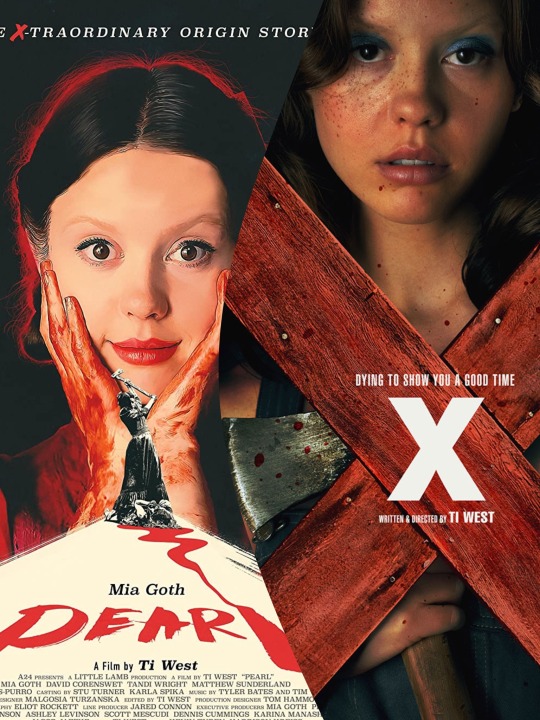
So, I recently just got done watching both of Ti West’s movies that are apart of his X-Traordinary film series. The original film titled X & its prequel Pearl. Here’s a brief review and analysis of what I like about both films.
Both films have an overall theme of sexuality, beauty, stardom, and womanhood. Through this, we realize how similar Pearl and Maxine are (and it’s not just because they’re both played by Mia Goth).
Pearl wanted so badly to be a star, that she would do anything to attain fame. She wanted to leave her dreary, farm life to perform on stage and in films for people to see, going as far as killing her parents to go to an audition. She doesn’t get the role and succumbs to her psychotic/sociopathic traits through murderous acts. Pearl comes to terms with never attaining her dreams of being a star, and lives the rest of her days on her farm with her husband, Howard. Maxine on the other hand went a more alternative route to her fame by staring in her boyfriend's adult films, in which during the ‘70s & ’80s sex became less of a taboo and more liberated, only to a slight degree that you could get paid for making adult content.
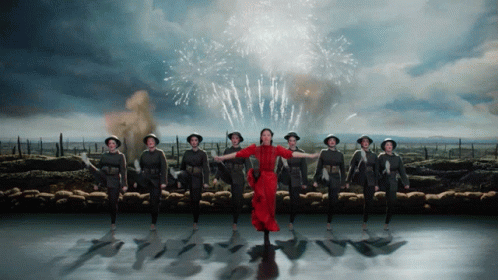

Wanting to be known, and admired is something many of us have dreamed of since we were young. Being a celebrity comes with a sense of intrigue and mystique. We’ve all had dreams of meeting a celebrity or befriending one when we were younger. I for one have always wanted to be known for my creativity and artistry. It’s tricky for many of us to attain stardom due to how limited industries are to get into. Whether we have the skillsets, the personality, or the charisma to entertain. Not everyone is lucky enough to be famous, however in this modern day and age, people can receive viral fame online, but there’s just something more… meaningful receiving attention in real life.
Both movies also commentate on the unfair advantage of women having to suppress their sensuality and explicit desires for the sake of purity. During Pearl’s prime, it was very taboo and a source of ridicule to express sexual desires with more than one man. She had a husband that left her to join the war, and she messed around with a guy that introduced her to adult movies. Another topic that I liked was how ageism plays a factor. Once you’re older, people may no longer find you beautiful, which does scare people into maintaining their youth for as long as they can.

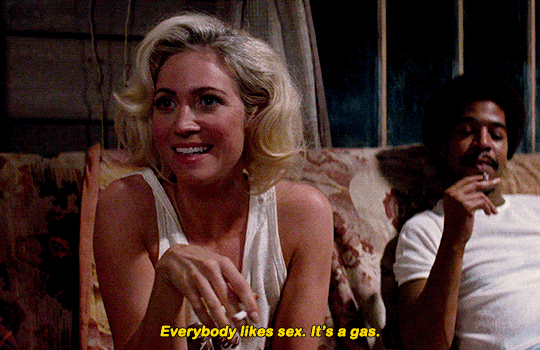
I’m interested to see where the final film “MaXXXine” takes Maxine Minx’s character. If she’ll eventually end up in the same cycle that Pearl had succumbed to, of not achieving her stardom — or if she will find success, but things get in the way of it. Like her father being a pastor, or people somehow finding out about the never-released film she starred in the night everyone was murdered.
I’ve gotta say, I love where Mia Goth’s career is going. Hell, her name is movie star material alone haha. I’m so glad to be witnessing a new generation of Final Girls and Scream Queens in modern media.
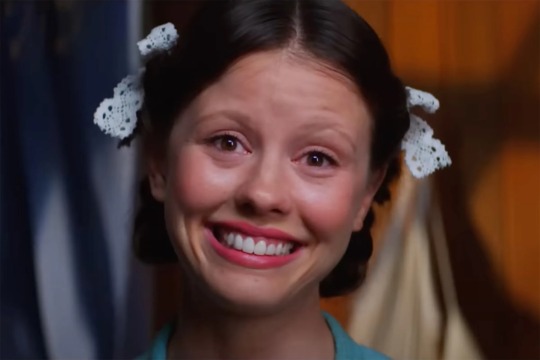
SCORE: 8.5/10 ⭐️
#cinema starview#pearl a24#pearl movie#x a24#x movie#ti west#mia goth#maxxxine#maxine minx#a24 films#slasher film#horror film#thriller drama#jenna ortega#kid cudi#brittany snow#owen campbell
25 notes
·
View notes
Text
What's the vibe? #52

News:
Within the past two weeks we've seen layoffs at Channel 4, LA Times, Pitchfork, Business Insider....job market is very rocky internationally at the moment. Not only that, more speaks about the legacy of culture writing and what it means when things like Pitchfork get folded into GQ or Channel 4 becoming digital?
Chaka Khan is curating this year's Meltdown @ Southbank Centre.



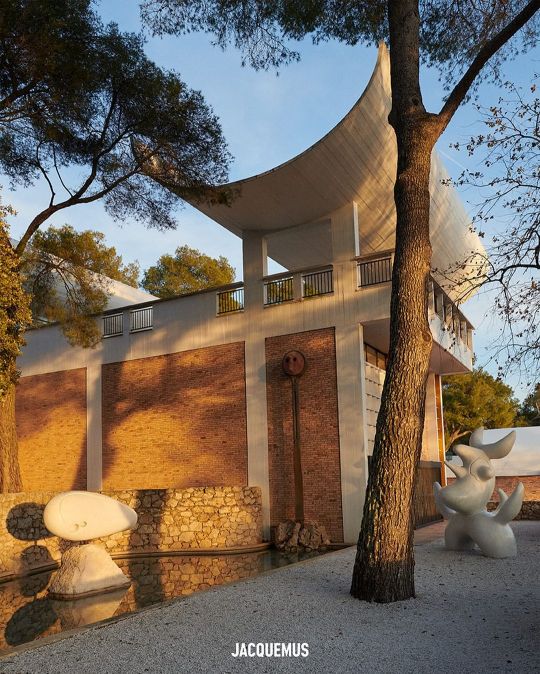

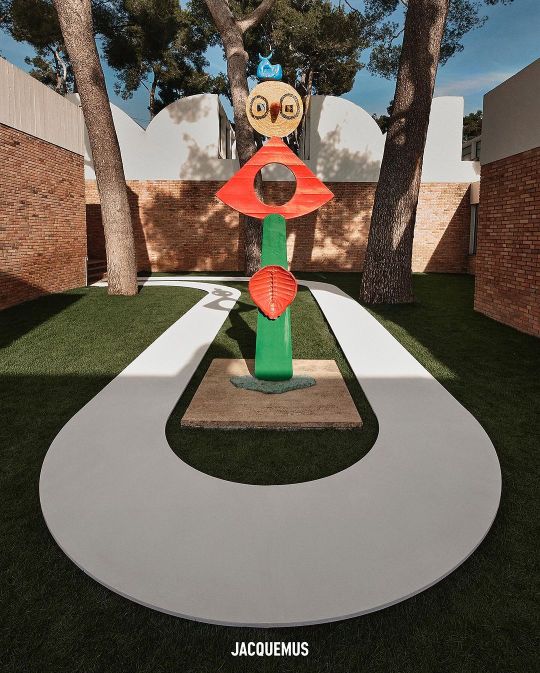
WIP: On Jacquemus show "Les Sculptures" + several sculpture shows:
Related to the ideas of the rise of craft - this encouragement to reject spectatorship and to make things. I still think we live in a perfectionist world but post pandemic, people were searching for intimacy and now, maybe people want to make intimate work?
see also: poetry, booktok, knowledge
I think in a year that is going to be very challenging - people are looking inwards towards the body and the power of the body - whether that's strength through the Olympics/Paralympics or performance at the Margiela show or just possibly the reinvigoration of unhealthy body image, a hangover from the 2000s. (Even pre-teens obsessing over having young skin at the beauty store) So things that represent the bodily form such as sculpture in this physical way will be in the limelight? (Getting to the conclusion of this soon.....)
Gender:

The stats that came out in this FT piece are quite concerning...but glad to know it's not just this and Matt Klein also goes through it slightly in his trend report....
I think it’ll be a defining topic to come over the next decade as this generation (18-35) grows up and start reaching into more mature adulthood and markers like marriage and children are either reached or not reached. And also what are the new markers of being human? These must include things that don't involve money, the foundations must be feelings/emotional.

One of the most interesting things I watched on the internet (hi TikTok) was an American young woman saying something like, “Men, you have to realise you’re not competing with other men; you’re competing with me”, basically saying you’re competing with her peace, her solitude etc etc. Young women are seeking peace away from violence, earning more money than ever and trying to create aesthetic spaces that represent them and young men are maybe not as visible or some are creating more harmful, misanthropic spaces?
To me it's not about how to be able to sell to people. You can think about that later. It's about societal stability, it's about the day to day lives of people and how if one gender feels out of step with the other, there will be these extreme reactions.....
The shows people have been talking about for the past few days...
JPG Couture X Simone Rocha
Make up by Thomas de Kluyver, nails by Ama Quashie, hair by Holli Smith

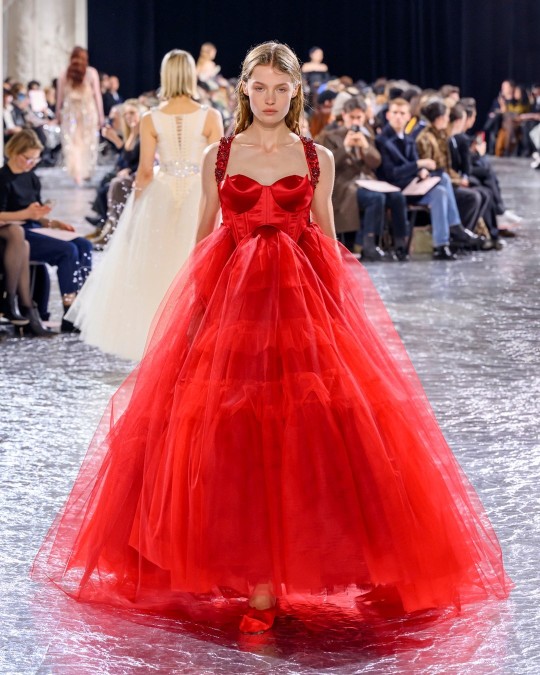
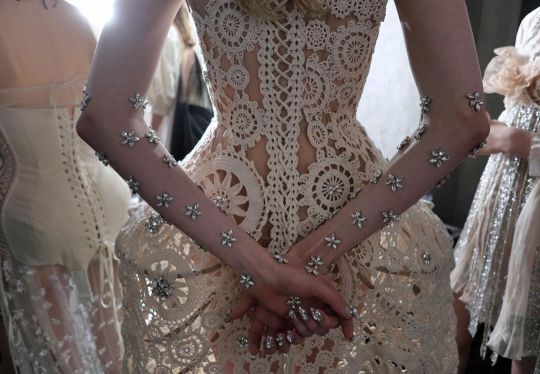



youtube
*****The STAR SHOW***** Maison Margiela Artisanal FW24 show -
What people loved: the performance, the movement of the models by Pat Boguslawski, the make up (which went viral and was by Pat McGrath) - teasing a collaboration with Christian Louboutin.
"The ritual of dressing is a composition of the self. With the body as our canvas, we build an exterior expressive of the interior: a form of emotion. The Maison Margiela 2024 Artisanal Collection paints a picture of the practices and occurrences that shape the character reflected within our dress. Under Pont Alexandre III, bathed in the light of the first full moon of the year, Creative Director John Galliano captures a moment in time: a walk through the underbelly of Paris, offline."

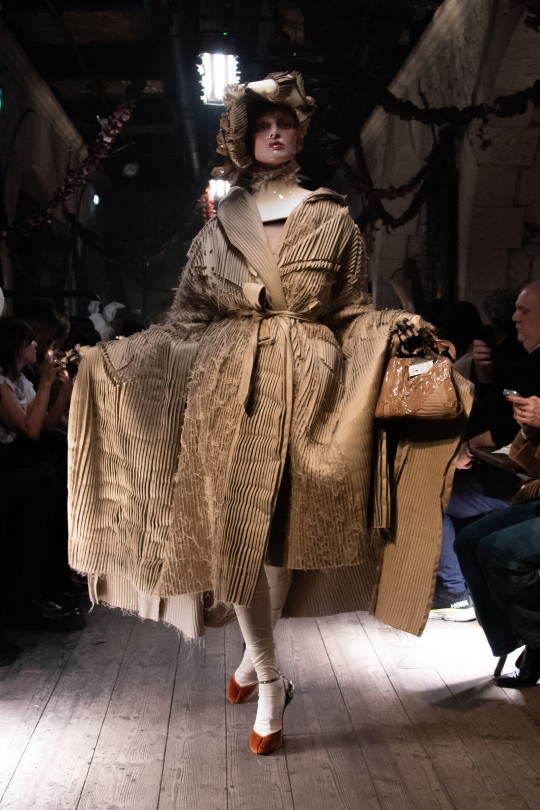
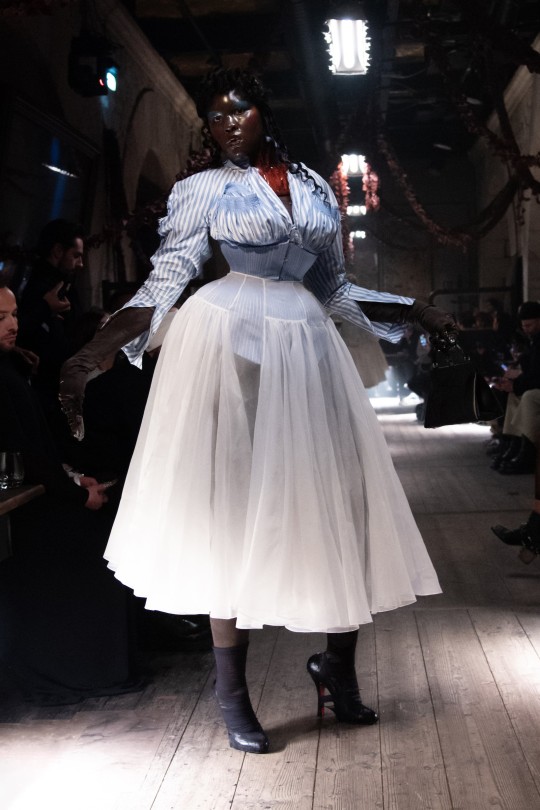
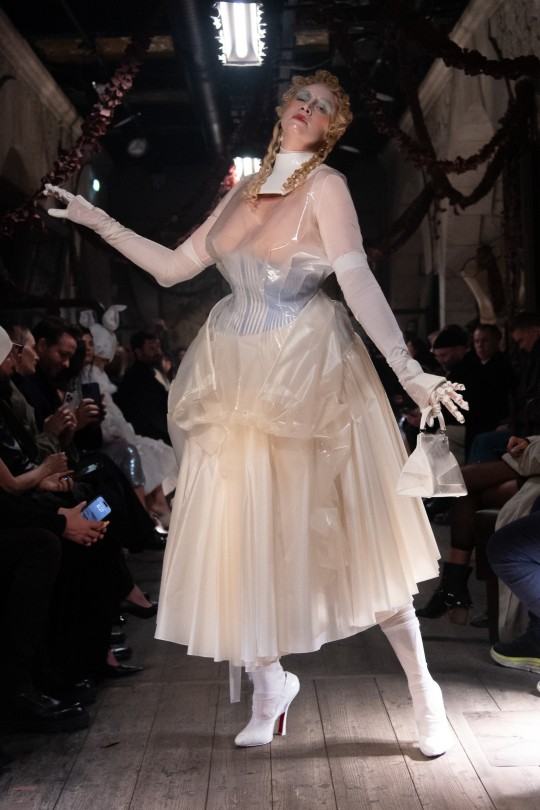
youtube
New Exhibitions:
Cute @ Somerset House
When Forms Come Alive @ Hayward Gallery
Last weeks of Rebel! @ Design Museum
Abbatoir - Aria Dean @ ICA
Reading List:
She finally made profit (good for her):
She’s also celebrating another milestone: brand profitability. After 14 years of business, Victoria Beckham finally clambered out of the red. VBHL revenues rose 44 per cent to £58.8mn in 2022, versus £40.9mn in 2021, and operating losses declined significantly year-on-year from £3.9mn to £0.9mn. This followed an injection by shareholders, including the Beckhams themselves and NEO Investments, of £6.9mn, steadying the business after a few unstable years. “The directors are pleased with the 111 per cent improvement in adjusted EBITDA for the year,” reads a company statement. “2022 marks a turning point where the group became profitable.”


An article about the changing landscape of the City of London incl plans for pedestrianisation.
2 notes
·
View notes
Text
Final Assignment
A holistic analysis of the film "Volver" by Pedro Almodóvar
Pedro Almodovar's film "Volver" is a vivid portrait of the intricate relationships that exist within families and the unbreakable bond that ties mothers and daughters together. Set in Madrid and the Spanish countryside, the film follows the story of Raimunda, played by Penelope Cruz, as she navigates the challenges of family, love, and loss. With Almódovar's signature blend of drama, humor, and sensuality, "Volver" is a film that immerses you in its world from the first frame, and leaves a lasting impression long after the credits roll.
The following is a holistic analysis of the film in accordance with the six perspectives of visual analysis.
Historical:
To truly grasp the historical context of "Volver," it is essential to examine Almodóvar's filmmaking career leading up to this particular film. Almodóvar emerged as a prominent figure in the "Movida Madrileña" movement during the transition from Francisco Franco's dictatorship to democracy in Spain. This artistic and cultural movement, which took place in the late 1970s and early 1980s, embraced freedom of expression, creativity, and a rejection of the repressive past. Almodóvar's early works, such as "Women on the Verge of a Nervous Breakdown" and "Tie Me Up! Tie Me Down!," showcased his unique blend of melodrama, comedy, and vibrant visuals that emerged as a result. These films’ bold challenge to social norms and exploration of “taboo” subjects reflected the changing Spanish society.
Continuing his exploration of female characters, Almodóvar portrays complex and strong female characters in "Volver" who navigate their lives with determination, despite the hardships they face. This portrayal aligns with the broader historical context of the feminist movements and the growing visibility of women in Spanish society. "Volver" also highlights the importance of storytelling and the interconnectedness of the past and the present. Almodóvar weaves a narrative that intertwines multiple generations, revealing how the actions and secrets of the past continue to impact the lives of the characters in the present. Through his storytelling, Almodóvar emphasizes the power of memory, personal history, and the need to confront and reconcile with one's past.
Cultural:
Almodóvar weaves the elements of family dynamics, death rituals, female empowerment, and visual aesthetics into a poignant narrative that serves as a testament to the complexities and richness of Spanish culture while also shedding light on universal themes such as love, loss, and ultimately resilience.
One of the key cultural contexts of the film is the importance of family and community ties within Spanish culture. The film revolves around a group of women who are portrayed as strong, resilient, and deeply connected to one another—serving to highlight the significance of such familial bonds within Spanish society. The film also explores the idea of women as the backbone of the family, embodying strength and a deep sense of duty to their loved ones. Accordingly, the film challenges traditional gender norms, presenting women as central figures and shedding light on their struggles, resilience, and agency; particularly in the face of adversity, as mentioned before.
Another culturally significant consideration is the theme of death and mourning in Spanish culture. The view of death as a communal experience in Spanish culture plays a significant role in the rituals and traditions surrounding mourning. Almodóvar captures this aspect in the film’s opening sequence, depicting women cleaning the graves at the cemetery, paying homage and respect to generations past. This scene also establishes the idea of death and the dead as active parts of their lives as well as the use of wind as a motif to visually represent supernatural presence.
Of course, the film also emphasizes the importance of remembering and honoring the deceased, while also highlighting the supernatural elements associated with death through the character of Irene, who returns as a ghost.
Furthermore, Almodóvar utilizes his signature visual style to enhance the cultural context of the film. The vibrant and saturated colors, combined with the use of flamenco music, create a distinctly Spanish atmosphere—reflecting the passion and vivacity often associated with the culture. The use of traditional Spanish houses, with their ornate interiors and courtyards also contributes to this.
Moreover, Almodóvar’s incorporation of magical realism works to blur the line between reality and fantasy, which is a technique commonly found in Latin American literature. His use of magical realism adds depth to the cultural aspect of the film, allowing for a deeper exploration of emotions, spirituality, and the interconnectedness of life and death.
Ethical:
The topic of death naturally presents ethical concerns. One of the notable aspects of Almodóvar's treatment of death in "Volver" is his ability to infuse it with a sense of humanity and empathy. Rather than depicting death as a mere plot device or a source of shock value, Almodóvar delves into the emotional complexities and consequences that death brings to the lives of the characters. By doing so, he humanizes death and highlights the universal experiences and emotions associated with losing a loved one. This considerably ethical approach allows the audience to connect with the characters on a deeper level and fosters a greater understanding of the impact of death on individuals within such communities.
The element of sexual abuse present within the film also calls for Almodóvar to handle the subject respectfully; maintaining the dignity of those abused by portraying such things accurately (though I cannot give too much credit) so as to not promote false narratives about victims or perpetrators of abuse. While the female characters in the film are portrayed as individuals who have endured hardships, they also possess the strength to triumph over them. By highlighting the agency and resilience of women and acknowledging the insidious nature of men, the film successfully challenges prevailing stereotypes that paint women as helpless victims and men as justified abusers. Even more, the dismissal of men's relevance in this film liberates it from becoming a polemic against them, choosing instead to delve into the profound exploration of female camaraderie and determination.
Technical:
The film was shot on 35mm film, using the Panavision Panaflex Platinum camera, which is a widely used camera in the film industry. Almodóvar worked with his regular cinematographer, Jose Luis Alcaine, who has collaborated with him on numerous films (https://shotonwhat.com/volver-2006).
Much of the film’s strength comes from its cinematography. The following is a brief breakdown of such:
Color:
As is true of his other works, Almodóvar’s use of color is an essential aspect of the film's visual language. The colors employed are not merely aesthetic choices but serve as powerful symbols, enhancing the narrative and serving to evoke profound feelings within the audience. The use of red (a signature of Almodóvar’s) in both costume and set design, for instance, effectively conveys danger, love, life, and death—the ties which bind the characters together. Furthermore, the film’s rich and vibrant color palette is evocative of the equally vibrant and colorful aesthetics of Spain, creating a sense of nostalgia for the country’s past as well as adding to the film’s overall cultural richness (see Figure 1).
Figure 1:

Color is also used in the film to distinguish and highlight the personalities of the characters. At times, the female characters, in particular, don bright and flamboyant dresses and other assorted outfits that symbolize their femininity and strength (see Figure 2). The distinct colors of their attire not only differentiate them visually but also contribute to the depth of their personalities, emphasizing their individuality and the complexities that lie within (see Figure 3). Moreover, the use of intense colors throughout the film creates a visual contrast when juxtaposed with darker or more muted tones, further imbuing the film with a sense of depth and complexity (see Figure 4).
Figure 2:
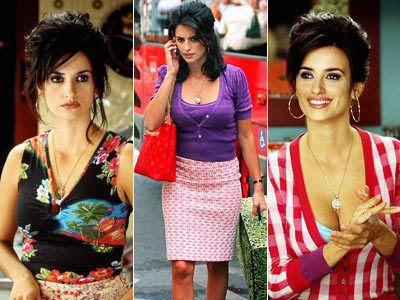
Figure 3:
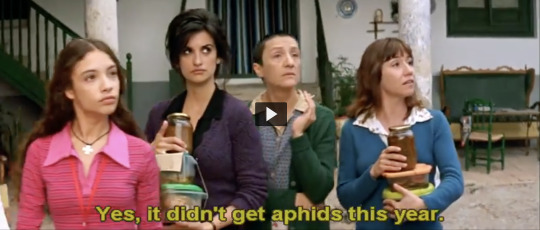
Figure 4:
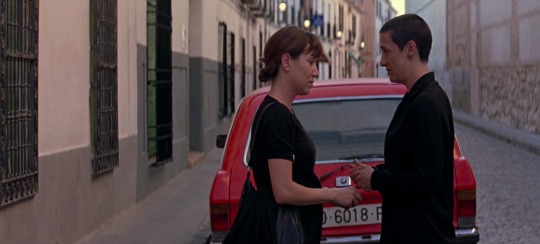
In addition to the color red, the color blue is featured prominently in scenes dealing with loss, mourning, and mortality. Associated with water and the sky, the color serves as a symbol of transformation and cleansing, possibly even freedom. As such, it is the primary color worn by Irene who gained all three through her own death and that of others (see Figure 5). Blue is also present in key scenes such as Raimunda cleaning up Paco's body in the kitchen (see Figures 6 and 7). Here, the color blue represents both literal cleansing as well as the symbolic cleansing of the burdens and secrets of the past. Through the act of cleaning, Raimunda not only scrubs away the physical remnants of death but also purges herself and her family of guilt, pain, and suppressed emotions of past and present.
Figure 5:
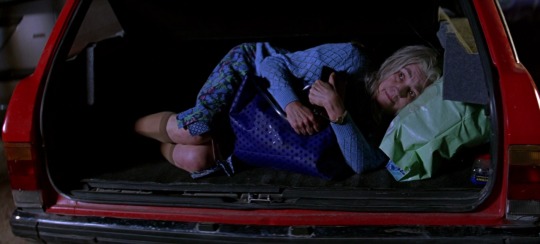
Figure 6:
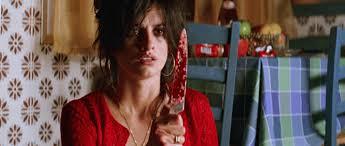
Figure 7:

Another use of the color blue is in the opening scene in which the buckets used by the women cleaning the graves are all the exact same hue of blue (see figure 8), once again symbolic of cleansing. However, such imagery also evokes the color’s connotation of loyalty; reiterating the dedication the living has to the dead. This idea of loyalty and the identical buckets also work to unify the women in the scene as various gestalt laws are employed to suggest this relationship such as the law of similarity, common fate, and symmetry (the similarly dressed women making similar movements each spaced and stationed at the neatly ordered graves).
Figure 8:
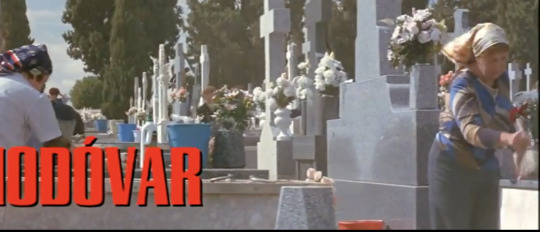
The various uses of color imply that death is not merely an end, but rather a transformative process that can lead to liberation and renewal. By incorporating blue into scenes associated with loss and mourning, Almodóvar suggests that these experiences can be catalysts for personal growth and liberation from emotional burdens. At the same time, he also conveys the “burden” bestowed upon the dead by the living.
Lighting:
The film uses warm and cool color temperatures to create a visual contrast between different settings and moods. For example, many of the interior shots are lit with orange and yellow hues, which create a warm and intimate atmosphere (see Figure 9). In contrast, scenes such as Raimunda with Paco in bed (see Figure 10) are lit with cool, blue tones, which add to the sense of emotional distance and detachment of the scene.
Figure 9:
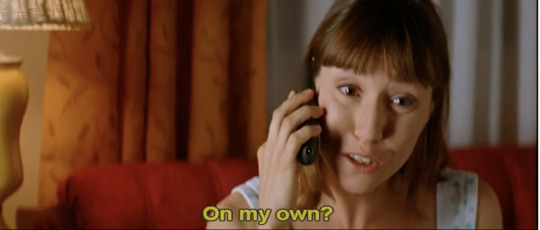
Figure 10:
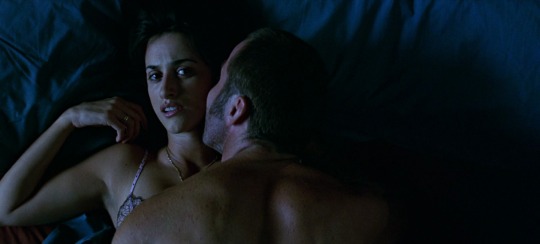
The film also uses natural light to great effect, especially in the scenes that take place outdoors (see Figure 11). Such natural light is often used to emphasize the film's elements of realism.
Figure 11:
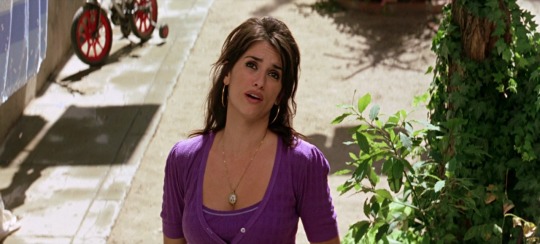
Camera Work:
The film was shot on 35mm film, using the Panavision Panaflex Platinum camera, which is a widely used camera in the film industry. Almodovar worked with his regular cinematographer, Jose Luis Alcaine, who has collaborated with him on numerous films (https://shotonwhat.com/volver-2006)
The camera often moves in a fluid and dynamic way, following characters as they move through different spaces. This creates a sense of energy and momentum and also helps to establish a sense of place and atmosphere (as seen in the beginning scene of Augustina walking through the cemetery). Many of the tracking shots in the film are filmed at eye level, creating a sense of intimacy and familiarity with the characters.
A variety of camera angles are used throughout the film to emphasize different aspects of the story. For example, in a scene where Raimunda's sister, Sole arrives at the funeral at Augustina’s house, the camera shows her point of view as she eerily makes her way through the house and catches a glimpse of her mother. In doing so, Sole’s anxiety and unease are transferred to the audience, creating suspense.
Overhead shots are used in the film to create a sense of detachment and objectivity as if the camera is an omniscient observer. For example, when Raimunda is cleaning the kitchen after Paco is killed, the camera takes an overhead shot, showing the body and the surrounding pool of blood from a detached perspective (see Figure 7). This contrasts with the close-up shot of Raimunda as she zips up his fly (see Figure 12). Here, the focus is on Raimunda’s face, emphasizing the emotions she is feeling. Her actions (zipping Paco’s fly) are implied through the flipping of the body, the direction of her eyes, her limited movements, and the sound of the zipper. Throughout the cleaning scene, the overhead shots are cut with close-ups of bloodied paper towels and other miscellaneously framed shots of bloodied cleaning supplies (see Figures 13 and 14), possibly to mimic Raimunda’s state of mind as she switches between dissociation and visceral awareness of the situation. This also works to emphasize the connection between Raimunda’s cleaning job at the airport and her matriarchal duties.
Figure 12:
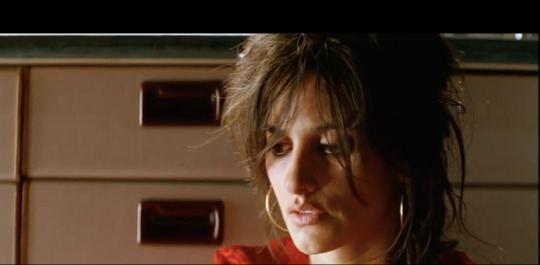
Figure 13:

Figure 14:
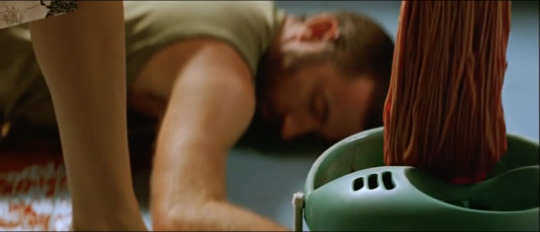
Close-up shots are heavily employed throughout the film. Another instance is when Raimunda is cleaning the blood off of the knife in the sink (see Figure 15). This shot is contrasted with the earlier over-head shot of Raimunda cleaning the same knife at the sink, just after she had told Paula to close her legs (see Figure 16). The over-head shot frames Raimunda to emphasize her chest, giving the audience the point of view of looking down her shirt. In doing this, Raimunda is being sexualized the same way her daughter just was. This, when paired with the murder weapon, creates a full-circle moment that completes the earlier foreshadowing.
Figure 15:
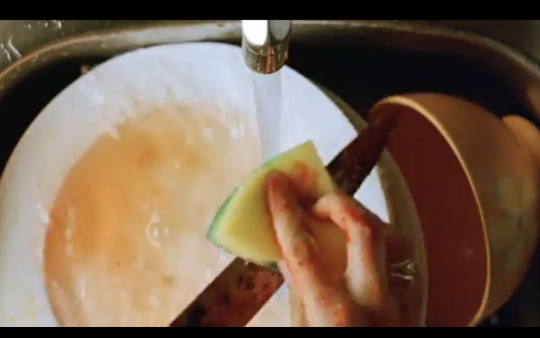
Figure 16:
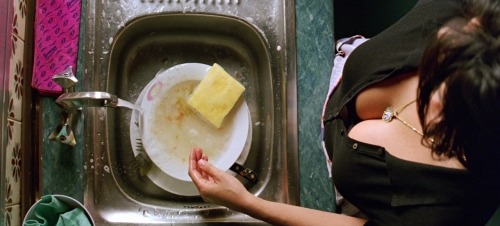
Several extreme long shots and wide shots are used to show the characters in their environment and convey a sense of space and scale, specifically when driving through the field of windmills (see Figures 17 and 18).
Figure 17:

Figure 18:

Critical:
“Volver” was met with critical acclaim, receiving nominations for numerous awards such as the Golden Globes and Critics Choice Awards for Best Foreign Film. It also won several awards for Best Screenplay and both Almodovar and Penelope Cruz were nominated and awarded for their accomplishments regarding the film. The success of the film was due in large part to the following:
Almodóvar's Aesthetic Mastery:
Pedro Almodóvar's unique visual style is prominently displayed in "Volver," combining vibrant colors, flamboyant production design, and a keen attention to detail. The film's saturated palette creates a visually stimulating experience that contrasts the seemingly mundane setting of a Spanish village. Almodóvar's deliberate juxtaposition of striking visuals with everyday scenes amplifies the emotional depth of the characters' journeys, enveloping the audience in a world that blurs reality and fantasy.
Female Empowerment and Identity:
"Volver" is a testament to Almodóvar's commitment to portraying strong, multifaceted female characters. The film's narrative primarily revolves around Raimunda and her resilience in the face of familial tragedy. Almodóvar explores the complexities of womanhood, presenting female characters who challenge traditional gender roles and societal expectations. Raimunda's journey from victimhood to empowerment, her ability to support her family, and her unwavering determination portray a narrative of female strength and agency.
Cultural and Social Commentary:
Almodóvar subtly addresses various cultural and social issues prevalent in Spain. The film explores themes of familial duty, highlighting the traditional values and close-knit communities of rural Spain. Almodóvar uses the backdrop of the small village to examine the intersecting roles of religion, superstition, and patriarchy, ultimately questioning their influence on women's lives. By intertwining these societal elements, Almodóvar presents a critique of the limitations imposed on women and the importance of breaking free from oppressive norms.
The Intricacy of the Narrative:
"Volver" showcases Almodóvar's ability to interweave multiple storylines and narratives seamlessly. The film oscillates between moments of drama, suspense, and dark comedy, engaging the audience through its intricate plot twists and character dynamics. Almodóvar's direction ensures that each character's arc is given due attention, creating a multi-layered scape that sees the past repeat itself, the dead come back to life, and the painfully concealed return to the fore.
Personal:
I will admit that most of the praise given throughout this analysis is in regard to the film’s cinematography. Almodóvar’s mastery of color, lighting, camera techniques, composition, and genre-blending elevates the film beyond its narrative and makes it a visually captivating experience. Objectively, I can understand the acclaim the movie received regarding its screenplay. However, it is not a movie that I would personally consider note-worthy outside of its visual language.
I believe that part of my opinion stems from the cultural/language barrier. I have not watched many foreign comedies, but the ones that I have watched I did not find all that funny. Because humor relies so heavily on social and cultural awareness, when that awareness is absent, often so is the humor.
I had no issue with the subject matter, in fact, I can relate to it on multiple levels. However, I found that my emotions were more wrapped up in the visuals rather than the narrative. Overall, I think it comes down to it just not being my cup of tea.
13 notes
·
View notes
Text
Intimate Words: What Emily Dickinson’s Letters to Susan Huntington Reveal about Love and Art
Emily Dickinson, one of the most celebrated poets in American literature, is known not only for her profound poetry but also for her intimate correspondence with friends and family. Among these relationships, her letters to her sister-in-law, Susan Huntington Dickinson, stand out as a poignant exploration of love, longing, and artistic expression. This blog delves into the rich tapestry of emotions and thoughts conveyed in these letters, highlighting how they illuminate the themes of love and art in Dickinson's life and work.

1. The Significance of Correspondence in Dickinson's Life
Emily Dickinson’s letters are a vital part of her literary legacy. Through her correspondence, readers gain insight into her inner world, her relationships, and the creative process that shaped her poetry. This blog focuses on the letters to Susan, emphasizing the unique bond they shared and how it influenced Dickinson's artistic voice.
2. A Brief Biography of Emily Dickinson
To understand the context of her letters, it’s essential to consider Dickinson’s life. Born in Amherst, Massachusetts, in 1830, Dickinson lived much of her life in seclusion, producing nearly 1,800 poems, most of which were published posthumously. Her reclusive nature and the societal expectations of women in her time shaped her correspondence, particularly with Susan, who was both a confidante and a source of inspiration.
3. The Relationship Between Emily and Susan Dickinson
3.1. Familial Ties
Susan Huntington Dickinson was Emily's sister-in-law, married to her brother Austin. The close familial relationship provided a unique foundation for their correspondence. This section explores how familial bonds influenced their emotional exchanges.
3.2. The Emotional Depth of Their Connection
The letters reveal a deep emotional bond characterized by affection and longing. Dickinson often expressed her feelings towards Susan through affectionate nicknames and intimate thoughts, showcasing a unique blend of platonic and romantic love.
4. Themes of Love in Dickinson’s Letters
4.1. Romantic Longing
Many of Dickinson's letters to Susan contain expressions of yearning and desire. This section will analyze specific letters that exemplify this longing and how it permeates her poetry.
4.2. The Complexity of Female Relationships
Dickinson’s letters challenge the notion of romantic love, showcasing the depth of female friendships during the 19th century. By examining these relationships, readers can appreciate the multifaceted nature of love that Dickinson portrayed.
4.3. Love as a Source of Inspiration
Love is not only a subject of Dickinson's correspondence but also a catalyst for her creative output. This section discusses how her feelings for Susan inspired some of her most famous poems.
5. The Artistic Expression in Dickinson’s Letters
5.1. The Poetic Nature of Her Prose
Dickinson’s letters are often as lyrical as her poems. This section highlights the poetic elements present in her correspondence, showcasing her distinctive voice and style.
5.2. Use of Imagery and Metaphor
Dickinson employed rich imagery and metaphor in her letters, reflecting her poetic sensibilities. This analysis includes examples of vivid imagery that enhance the emotional weight of her words.
5.3. The Interplay of Love and Art
Dickinson’s letters reveal how her experiences of love influenced her artistic expression. This section examines the connection between her emotional life and her creative output.
6. The Role of Nature in Dickinson’s Correspondence
Nature frequently appears in Dickinson's letters, serving as a backdrop for her reflections on love and art. This section explores the symbolism of nature in her correspondence and its connection to her emotional state.
7. The Significance of Correspondence in 19th Century Literature
7.1. Letters as a Literary Form
During Dickinson’s time, letters were a primary mode of communication, often serving as a form of literary expression. This section discusses the importance of letters in 19th-century literature and how Dickinson’s correspondence fits into this tradition.
7.2. Letters as a Reflection of Societal Norms
Dickinson's letters provide insight into the societal norms of her time, particularly regarding gender roles and expectations. This analysis will highlight how her correspondence challenges or conforms to these norms.
8. Historical Context: The Civil War and Its Impact on Dickinson
The Civil War era profoundly affected Dickinson and her contemporaries. This section discusses how the historical context of the time influenced her letters and poetry, particularly regarding themes of loss and longing.
9. The Legacy of Emily Dickinson’s Letters
9.1. Influence on Modern Literature
Dickinson’s letters have had a lasting impact on modern literature, inspiring countless writers and poets. This section explores how her intimate words have resonated through the ages.
9.2. The Continued Study of Dickinson’s Correspondence
The ongoing scholarly interest in Dickinson's letters highlights their importance in understanding her life and work. This section will summarize recent studies and publications that analyze her correspondence.
10. Statistical Insights: The Reach of Dickinson’s Letters
10.1. Publication of Letters
Since the publication of "Open Me Carefully: Emily Dickinson’s Intimate Letters to Susan Huntington Dickinson," interest in Dickinson's letters has surged. Statistics on sales, readership, and academic citations will be discussed here.
10.2. Social Media and Dickinson’s Legacy
In the digital age, Dickinson's letters have gained new audiences through social media platforms. This section will present statistics on how her work is shared and discussed online.
11. Personal Reflections: What Dickinson’s Letters Mean Today
11.1. Relevance in Contemporary Society
Dickinson's exploration of love and art remains relevant in today’s society. This section discusses how her letters can inspire modern readers in their personal and artistic endeavors.
11.2. Lessons from Dickinson’s Life and Work
This section reflects on the lessons readers can draw from Dickinson’s life, particularly regarding love, creativity, and the importance of authentic expression.
12. Conclusion
The letters between Emily Dickinson and Susan Huntington offer a profound glimpse into the heart of one of America’s greatest poets. Their correspondence not only illuminates the themes of love and art but also showcases the complexity of human relationships. Dickinson’s intimate words continue to resonate, reminding us of the enduring power of love and creativity.
13. Suggested Further Reading
For those interested in exploring more about Emily Dickinson and her letters, here are some recommended readings:
"Open Me Carefully: Emily Dickinson's Intimate Letters to Susan Huntington Dickinson" edited by Martha Nell Smith and Ellen Louise Hart.
"The Letters of Emily Dickinson" edited by Thomas H. Johnson.
"Emily Dickinson: A Biography" by Richard B. Sewall.
14. Engaging with Dickinson: Creative Exercises
14.1. Writing Your Own Letters
Encourage readers to write their letters inspired by Dickinson’s style. Reflecting on their own experiences of love and art can be a powerful exercise in creativity.
14.2. Exploring Themes of Love in Poetry
Readers can explore the theme of love in their poetry, drawing inspiration from Dickinson’s work. Consider creating a personal anthology of poems focused on love.
15. Final Thoughts
Emily Dickinson’s letters to Susan Huntington Dickinson are not merely personal correspondence; they are a rich exploration of love, longing, and artistic expression. Through these intimate words, we can understand not only Dickinson's heart but also the universal themes that continue to speak to us today. As we reflect on her correspondence, we are reminded of the power of words to connect us across time and space.
0 notes
Text
🌐 Week Three: Digital Communities & Tumblr ✨
Welcome to Week Three, where we dive into the fascinating world of digital communities on Tumblr! 🌟 Tumblr isn’t just a platform, it’s a cultural space where online identities, activism, and creative expressions converge. Whether you’re curating a mood board or leading a feminist movement, Tumblr's unique community dynamics make it a key player in shaping digital culture.
🔗 The Power of Hashtags & Movements
Hashtags like #BodyPositive have revolutionized the way we discuss self-image and inclusivity. Reif et al. (2022) highlight that the #BodyPositive hashtag on Tumblr allows women to share diverse body images, encouraging self-acceptance over unrealistic beauty standards (Reif et al. 2022). However, the challenge remains in balancing self-expression with self-objectification, as social media often pressures users to conform to traditional beauty ideals.
Tumblr's history as a subcultural hub was seriously disrupted when it implemented its controversial NSFW content ban in 2018. Users lost not only artistic and expressive freedom but also entire communities that thrived in the platform’s lenient environment (Pilipets & Paasonen 2022). The backlash, seen through memes, screenshots, and GIFs, turned the issue into an emblem of algorithmic failure and censorship. Users responded by creating memes mocking the algorithm, uploading innocent images (like pictures of cats) that were flagged as inappropriate. This resulted in what has become known as the "Tumblr Purge."
✊ Activism & Feminism
Digital communities on Tumblr are also integral to online activism, with movements like Tumblr Feminism gaining ground through creative posts, memes, and hashtags. Keller (2019) explores how teenage girls use Tumblr to voice their feminist critiques, creating a distinctive vernacular that reflects the platform’s creative affordances (Keller 2019). Tumblr offers an inclusive space for young feminists to challenge gender norms and express their ideas freely.
Yet, while Tumblr is a great space for activism, it has its limitations as a platform for political discourse. Kruse, Norris, and Flinchum (2018) note that social media, including Tumblr, often falls short of Habermas’s ideal public sphere, which is meant to foster democratic debate. Instead, users tend to seek like-minded communities, creating echo chambers where diverse perspectives are often missing (Kruse et al. 2018).
🎭 Memes, GIFs, and Digital Resistance
Want to make this week’s post even more engaging? Why not throw in a meme or GIF that embodies the iconic Tumblr humor or critique? For instance, a "This post has been flagged as inappropriate" meme or a simple photo of a cat ironically labeled as NSFW (Pilipets & Paasonen 2022). These images not only poke fun at Tumblr’s censorship but also engage users in a visual language that resonates deeply within the community. Below is an example of a meme structure:

Whether you’re here for the memes, the activism, or the digital culture, Tumblr remains a vital space for creativity, self-expression, and connection.
References
Keller, J 2019, ‘Oh, She’s a Tumblr Feminist’: Exploring the Platform Vernacular of Girls’ Social Media Feminisms’, Social Media + Society, vol. 5, no. 3, pp. 1-11, <https://doi.org/10.1177/2056305119867442>.
Kruse, LM, Norris, DR & Flinchum, JR 2018, ‘Social Media as a Public Sphere? Politics on Social Media’, The Sociological Quarterly, vol. 59, no. 1, pp. 62-84, <https://doi.org/10.1080/00380253.2017.1383143>.
Pilipets, E & Paasonen, S 2022, ‘Nipples, memes, and algorithmic failure: NSFW critique of Tumblr censorship’, New Media & Society, vol. 24, no. 6, pp. 1459–1480, <https://doi.org/10.1177/1461444820979280>.
Reif, A, Miller, I & Taddicken, M 2022, ‘Love the Skin You’re In: An Analysis of Women’s Self-Presentation and User Reactions to Selfies Using the Tumblr Hashtag #bodypositive’, Mass Communication and Society, <https://doi.org/10.1080/15205436.2022.2138442>.
1 note
·
View note
Text
[Week 3] How does Tumblr function as a digital community?
What is Tumblr?
Tumblr is a social networking website that integrates blogging aspects with functionalities resembling those of Facebook and Twitter. It is characterized as a conglomeration of diverse theme blogs (Power 2014).
Users have the ability to subscribe to blogs, express approval, provide feedback, distribute content, and publish their own written material, hyperlinks, quotations, audio recordings, films, or visuals. The platform incorporates pre-existing communities and employs tagging to facilitate connections between users who share common interests.

Our mission?
This week, we will examine the operational mechanisms of Tumblr as a digital community through a thorough analysis of the research paper titled "Love the Skin You're In": A Comprehensive Study on Women's Self-Presentation and User Responses to Selfies Utilizing the Tumblr Hashtag #bodypositive, authored by Anne Reif, Insa Miller, and Monika Taddicken.

The study "Love the Skin You're In": An Analysis of Women's Self-Presentation and User Reactions to Selfies, shed light on the complexities of online feminist spaces and the use of social media for body positivity by utilizing the Tumblr hashtag #bodypositive to provide insights into the diversity of self-presentation and user reactions within the #bodypositive community on Tumblr.
Expression and Identity: The selfies posted under the hashtag #bodypositive on Tumblr exhibit a diverse range of self-expression and exploration of personal identity (Hutchinson 2019). Tumblr users utilize selfies as a means to convey their own personalities, question societal beauty standards, and participate in significant discussions around body acceptance. For example, the research discovered that people in the group showcased their creativity through unique haircuts, androgynous looks, vibrant forms of self-expression, and prominent LGBTQIA+ affiliations (Keller 2019). This illustrates that Tumblr offers a forum where individuals feel empowered to genuinely express their identities, diverging from conventional beauty standards. By sharing personal stories, individuals in the #bodypositive community contribute to a shared sense of identity, creating a space that not only embraces but also celebrates a wide range of identities (Kruse, Norris & Flinchum 2018).
Diversity and Inclusivity: The research findings indicate that the #bodypositive community on Tumblr consists of a wide variety of members, including individuals with varied body shapes, ethnic backgrounds, and gender identities (Hutchinson 2019). The selfies showcase a diverse range of beauty viewpoints, including unconventional expressions that deviate from traditional standards. This includes vibrant and imaginative self-presentation styles, as well as the incorporation of LGBTQIA+ identities (Keller 2019). The wide range of perspectives and experiences represented within the #bodypositive community showcases Tumblr's dedication to fostering inclusiveness. Tumblr creates a space that welcomes and supports a wide range of identities and viewpoints. This allows users from many backgrounds to connect, share their stories, and contribute to a shared narrative of self-affirmation and inclusivity (Kruse, Norris & Flinchum 2018). The presence of diverse individuals not only poses a challenge to conventional beauty norms but also fosters an environment where people may feel affirmed and encouraged in their distinct identities.

In conclusion, the findings from the "Love the Skin You're In Selfies" research conducted on Tumblr provide compelling evidence for the platform's role as a digital community. Through the lens of the #bodypositive community, the study illustrates how Tumblr serves as a dynamic space that fosters myriad expressions of identity and champions inclusivity. The members actively contribute to shaping a narrative that challenges societal norms, celebrating the distinctiveness of individual identities. In essence, the research reinforces the notion that Tumblr operates not merely as a social platform but as a thriving digital community where diversity is embraced, and self-assertion is celebrated.
References: Power, JL 2014, ‘Tumblr’, Journal of access services, vol. 11, no. 2, Taylor & Francis Group, pp. 91–96. Reif, A, Miller, I & Taddicken, M 2022, ‘“Love the Skin You‘re In”: An Analysis of Women’s Self-Presentation and User Reactions to Selfies Using the Tumblr Hashtag #bodypositive’, Mass Communication and Society, pp. 1038–1061, viewed 3 February 2024, <https://www.tandfonline.com/doi/full/10.1080/15205436.2022.2138442>.
Hutchinson, J 2019, ‘Micro-platformization for digital activism on social media’, Information, Communication & Society, vol. 24, no. 1, pp. 35–51, viewed 1 February 2024, <https://www.tandfonline.com/doi/full/10.1080/1369118X.2019.1629612>.
Keller, J 2019, ‘“Oh, She’s a Tumblr Feminist”: Exploring the Platform Vernacular of Girls’ Social Media Feminisms’, Social Media + Society, vol. 5, no. 3, pp. 1–11.
Kruse, LM, Norris, DR & Flinchum, JR 2018, ‘Social Media as a Public Sphere? Politics on Social Media’, The Sociological Quarterly, vol. 59, no. 1, pp. 62–84.
#MDA20009 #Week3 #TumblrasDigitalCommunity
1 note
·
View note
Text
[W3] How does Tumblr function as a digital community?
What is Tumblr?
Tumblr serves as a social network, a blogosphere and social media simultaneously. It provides high-quality content with rich multimedia content, which offers distinctive characteristics to attract young people. (Chang et al., 2014)
Tumblr is distinguished by its acceptance of NSFW content and its position as a forum for "emotional authenticity". It offers extensive space for written context, making it ideal for communication research (Renninger, 2015). Users can manage shared blogs and build communities using hashtags, allowing a broader diversity of viewpoints to be heard. Users also can interact with posts by liking, commenting, or re-blogging content, and these interactions are summarized in a single notes number. Tumblr discourages negative reactions and trolling by hiding specific reactions behind the summary.
Tumblr's openness has made it a place where people with similar interests and hobbies can readily connect with one another.

Tumblr is a place...
Content Creation and Sharing Dynamics:
Users on Tumblr actively create and curate content through their blogs, which serve as personalized platforms for expression. They have the opportunity to express themselves freely through their blogs, which act as personalized spaces for creativity, self-expression, and exploration. By curating content that reflects their interests, passions, and identities, users contribute to the rich tapestry of diverse content on Tumblr.

For example, Tumblr turned sex into a communal experience. Users feel free to share their experiences, concerns, and viewpoints without fear of being judged or censored, leading to a culture that challenges old stigmas and prejudices about sexuality.
“Tumblr was the first place I’d experienced porn presented as having aesthetic and cultural value...This open sharing was so desperately vital for women and other marginalized people whose sexualities were and are often overlooked or infantilized in media about sex in preference for the tastes of the traditional porn consumer – the straight guy. Tumblr dismantled that. It allowed for sex in a space that didn’t feel like it was created and dominated by male desire. For many, it’s cited as the first time they connected with and enjoyed porn” (Ashley, 2019).
Whether they're sharing personal anecdotes, re-blogging content from others, or showcasing their creative projects, each blog reflects the unique voice and perspective of its creator. This aspect of personalized expression is a cornerstone of Tumblr's appeal, as it empowers users to share their stories, connect with others, and contribute to a vibrant and dynamic digital community.

That's mean on Tumblr we can...
Form Communities and Express Identities:
Tumblr facilitates the formation of communities based on shared interests, identities, and causes through features like following, tagging, and search. Interactions like, comment, re-blog summarized in notes to discourage negative reactions, trolling (Cavalcante, 2018). Users can openly and without judgment share their identities, views, and experiences via written postings, photographs, artwork, and other forms of media. This freedom of expression enables individuals to showcase their distinct ideas, passions, and talents, contributing to a diverse and vibrant community where every voice is appreciated.
In the research “Love the Skin You‘re In”: An Analysis of Women’s Self-Presentation and User Reactions to Selfies Using the Tumblr Hashtag #bodypositive (Reif, Miller and Taddicken, 2022), researchers explored self-presentation on Tumblr by conducting a content analysis of 300 selfies posted by female users in 2017 with the hashtag #bodypositive. After the research, the found that #bodypositive on Tumblr indeed offers a valuable community for women to connect, support each other, and embrace their bodies. It is a female-dominated space focusing on body image, self-love, and fitness, where people discuss their experiences to self-acceptance. The community offers a friendly environment in which women can openly discuss their body positivity experiences, problems, and successes.

Overall, Tumblr created positive digital communities in which people can communicate, discuss, be more open and confident with themselves and each other.
References:
Ashley, V. (2019). Tumblr porn eulogy. Porn Studies, 6, pp.1–4. doi:https://doi.org/10.1080/23268743.2019.1631560.
Cavalcante, A. (2018). Tumbling Into Queer Utopias and Vortexes: Experiences of LGBTQ Social Media Users on Tumblr. Journal of Homosexuality, 66(12), pp.1715–1735. doi:https://doi.org/10.1080/00918369.2018.1511131.
Chang, Y., Tang, L., Inagaki, Y. and Liu, Y. (2014). What is Tumblr. ACM SIGKDD Explorations Newsletter, 16(1), pp.21–29. doi:https://doi.org/10.1145/2674026.2674030.
Reif, A., Miller, I. and Taddicken, M. (2022). “Love the Skin You‘re In”: An Analysis of Women’s Self-Presentation and User Reactions to Selfies Using the Tumblr Hashtag #bodypositive. Mass Communication and Society. doi:https://doi.org/10.1080/15205436.2022.2138442.
Renninger, B.J. (2015). ‘Where I can be myself … where I can speak my mind’ : Networked counterpublics in a polymedia environment. New Media & Society, 17(9), pp.1513–1529. doi:https://doi.org/10.1177/1461444814530095.
0 notes
Text
Week 3: Tumblr Case Study
Tumblr, a microblogging and social networking platform, has been a hotspot for creative expression, personal narratives, and social activism since its inception in 2007. With its unique blend of traditional blogging and social networking features, Tumblr attracts users seeking a versatile platform for self-expression and community engagement. Selfies, self-portrait photographs often enhanced with filters and editing apps, have become a staple of online self-representation on Tumblr. According to Reif et al., (2022) despite the multifaceted appeal of Tumblr, this platform has garnered attention for several specific reasons, most notably its amalgamation of traditional blogging and social networking elements. This distinctive combination has made Tumblr a preferred choice for individuals sharing their creativity, personal stories, and social movements aiming to connect with a diverse and engaged online audience.
Nevertheless, the practice of posting extensively edited selfies can give rise to a range of issues. The act of sharing retouched selfies on social media platforms, including Tumblr, contributes to the perpetuation of unrealistic beauty standards and can have adverse effects on individuals' self-esteem. The pressure to conform to these standards and project a flawless image can lead to feelings of inadequacy and insecurity. Furthermore, it fosters a culture of comparison, where individuals gauge their self-worth against idealized portrayals that may not accurately represent reality. The pursuit of perfection through edited images can also take a toll on mental health, as individuals may become preoccupied with their physical appearance and seek validation through likes and comments.
Amid the prevalence of edited selfies and the associated challenges, Tumblr has witnessed the rise of the body positive movement, which has also spread to other social media platforms. This movement, often identified by the hashtag #bodypositive, emerged as a response to society's narrow beauty ideals and the detrimental impact of heavily edited images. Within the Tumblr-based body positive community, a predominant demographic emerges: primarily young individuals with fair skin, often possessing a moderate body weight. In their self-portraits, they tend to obscure skin imperfections such as acne or scars. Consequently, research findings revealed that the representation of female role models on Tumblr was less diverse than anticipated, with content predominantly revolving around themes of self-acceptance, self-improvement, or a blend of both. Notably, self-acceptance themes took precedence over self-improvement.
In addition, the research of Reif et al., (2022) uncovered the presence of a small number of negative posts publicly shared. Engagement metrics demonstrated that women aged 26 to 35 received more interactions than their counterparts aged 16 to 25 or those above 35. Additionally, notes and engagement were more common for white women compared to women of color. Notably, women presenting themselves in clothing that revealed more skin tended to receive more interactions than fully clothed or nude individuals. The Tumblr-based body positive movement nurtured a supportive community that challenged conventional beauty standards, championed inclusivity, and heightened awareness regarding the significance of body positivity. This movement played an instrumental role in empowering individuals to cast aside the pressure to conform to edited images and instead embrace their authentic selves. These research findings provide insight into the dynamics of the body positive movement on Tumblr, showcasing the platform's potential to promote self-acceptance, challenge societal beauty norms, while also highlighting specific trends and disparities within the community.
Reference:
Reif, A., Miller, I., & Taddicken, M. (2022). “Love the Skin You‘re In”: An Analysis of Women’s Self-Presentation and User Reactions to Selfies Using the Tumblr Hashtag #bodypositive. Mass Communication and Society. https://doi.org/10.1080/15205436.2022.2138442
1 note
·
View note
Text
Revealing Denny JA’s chosen work 35: “Apart from the bomb, I called your name in silence”
In the world of Indonesian literature, the name Denny JA is familiar. He is a famous author who has spawned many of his workwritten work. This year, Denny JA celebrated his 35th birthday as a writer by releasing his latest essay poem entitled “Apart From Bombs, I Called Your Name in Silent”. In this article, we will reveal more about this 35th Denny Ja selected work. “Apart from the bomb, I call your name in silence” is an essay poem that carries the theme of the life and struggle of a woman. In this essay poem, Denny JA explores many aspects of women’s lives, ranging from love, violence, to the struggle for freedom. One of the interesting things about this essay poem is the use of subtle and beautiful language. Denny JA is able to describe the emotions and feelings of his character very deeply through the language he chose. He also uses a distinctive and unique language style, making this work so attractive to its readers. In this essay poem, Denny JA also succeeded in presenting complex and multidimensional characters. Each character has a background and journey of his own life, which makes the reader emotionally connected with them. Denny JA also presents an interesting and unexpected conflict, making this story so interesting to follow. In addition, this essay poem also presents a tempatema that is relevant to the current community, such as domestic violence, sexual harassment, and the struggle of women to get their rights. Denny JA was able to convey important messages through the story he wrote, thus making the reader more sensitive to the social issues that are around them. Not only that, “Apart from the bomb, I call your name in silence” also has a good structured storyline. Denny JA is able to maintain tension and surprise in each chapter, thus making the reader continue to want to read further. He also uses intelligent and tempting telling techniques, making this essay poem difficult to leave. In this essay poem, Denny JA also shows his expertise in combining various literary elements. He uses the language of poetry, prose, and dialogue very well, thus creating a deep and beautiful impression for the reader. He also uses a strong visual description, so that the reader can clearly imagine every scene in the story. This 35th Denny JA elected work is also inseparable from the criticism and appreciation of literary critics. Many praised Denny Ja’s expertise in presenting a strong and meaningful story. Some critics also highlighted the sharpness of the social analysis displayed in this essay poem. However, there are also some critics who consider that this essay poem is too complex and difficult for ordinary readers to understand. Overall, “Apart from the bomb, I called your name in silence” was an extraordinary work from Denny Ja. He is able to present interesting stories, strong characteristics, and important messages. This essay poem not only entertains, but also invites readers to reflect and realize the importance of women’s struggles in society. Denny JA has shown his expertise in writing and expressing quality work over the past 35 years. His latest work is always awaited by literary fans in Indonesia. Our hope is that Denny JA continues to be creative and produce work that inspires and gives meaning to the community.
Check more: Uncover the 35th selected work of Denny JA: “Apart from the bomb, I call your name in silence”
0 notes
Text
WEEK 3: TUMBLR…. AS A DIGITAL COMMUNITY AND A PUBLIC SPHERE.
An iteration from Habermas ([1989]1991) on Public Sphere, A place where “private people come together as a public” (Flinchum, Kruse & Norris 2018 p.62). Tumblr is a platform that allows users to freely voice out their opinions and thoughts creatively while finding likeminded content through hashtags and reblogged posts from other users and forming a creative and digital community. Tumblrs’ specialty is that users are allowed to keep their anonymity as they are not tied to their real names. Hence, makes it a comfortable and safe space for people to share what they cannot express on other social media platforms due to the fear of judgement or criticism.
As Cwynar-Horta said, the majority of Western mass media still upholds a narrow standard of female attractiveness that is nearly impossible for women to achieve. (Reif, Miller & Taddicken 2022. P.1) Hashtags make it easy for users to connect with other like-minded people. In contrast to general mainstream hashtags such as #selfie where selfies are often edited and posted on social media to fit into stereotypes of unrealistic expectations of society, the use of specific hashtags such as #bodypositive on tumbler helped to make diverse forms of femininity and body types be it plus size, petite, people of color or Transgender be more visible and a source for empowerment to be themselves (Reif, Miller & Taddicken 2022. P.4) Tumblr is also known as a site of emotional authenticity for people to be open and honest while forming counter public spaces for marginalized and progressive communities to feel a sense of comfort knowing there are others facing the same struggles and that they are not alone. (Reif, Miller & Taddicken 2022. P.6|7)
‘Tumblr is the easiest digital space to practice feminism as a young person’ says Jessalynn Keller in “Oh, she’s a Tumblr Feminist”: Exploring the Platform Vernacular of Girls’ Social Media Feminisms” (Keller 2019. p.7) after a focus group conversation with several young London school girls. She says that young teenagers are more drawn to Tumblr to speak about their experiences with sexism rather than Twitter or Facebook where they have a fear of being attacked or judged unfairly. (Keller 2019. p.7). In conversation with Dara, a 14-year-old girl she says “when I have experienced [sexism], I don’t really feel like putting it on Twitter because I just feel like I’ll be attacked for it. And actually, I want to put it out here so people know this stuff is going on” (Keller 2019. p.7|8). she goes on to say she would share her experience on Tumblr as she feels anonymous and a lot safer (Keller 2019. p.8). On Tumblr, there is a less negative commentary and more helpful conversation that fosters a feeling of community and acceptance.
Concluding, Tumblr as a public Sphere and a Digital community Is an inclusive space for people from marginalized and minority groups to feel a sense of acceptance and safely discuss controversial topics without the fear of misunderstanding from society.

References
Kruse, LM, Norris, DR & Flinchum, JR 2017, ‘Social Media as a Public Sphere? Politics on Social Media’, The Sociological Quarterly, vol. 59, no. 1, pp. 62–84.
Reif, A, Miller, I & Taddicken, M 2022, ‘“Love the Skin You‘re In”: An Analysis of Women’s Self-Presentation and User Reactions to Selfies Using the Tumblr Hashtag #bodypositive’, Mass Communication and Society, pp. 1–24.
Keller, J 2019, ‘”Oh, She’s a Tumblr Feminist”: Exploring the Platform Vernacular of Girls’ Social Media Feminisms’, Social Media + Society, vol. 5 no. 3, pp. 1-11.
1 note
·
View note
Photo

I’m Looking Forward Now 💖Thank you and good bye
So, it’s been a little over a week since Steven Universe Future ended…
I’ve been hesitant to write this, honestly, but I’m tired of holding myself back from properly expressing myself in fear of appearing overly invested in the media I consume, even in private. Writing helps me organize my thoughts and feelings, and I feel like these thoughts in particular may resonate with many, so I want to share them. I want to talk about what Steven Universe has done for me personally, both as an artist, and as a person.
I’ve been around since the day the first episode of the original series aired. I actually remember when Steven Universe was just a logo on Wikipedia’s “List of Upcoming Cartoon Network Shows” list, back when I was a freshman in high school. It piqued my interest, but when commercials finally dropped for it, I thought it was going to be bad because of the way marketing handled introducing Steven as a likeable character. There was still something about it that made me want to give it a chance though, so I went online and watched the pilot before the first episode's release. I was hooked immediately. I knew I was going to love it, and I did. I fell so absolutely in love with Steven as a character, and the world that he and the gems lived in. I became obsessed. I was always so excited for new episodes to come out. Little did I know what else it would do for me as I went through my adolescence alongside it.
As the show progressed, it was evident that what I wanted out of a western animated childrens’ cartoon was finally coming into fruition: this show was becoming serialized. There was continuity, there was plot, there was character development-- it was getting deep. It was pushing the groundwork that Adventure Time laid out even further (thank you, Adventure Time).
I will give credit where credit is due: earlier western childrens’ cartoons I grew up with like Hey Arnold, and Rugrats, among others, also touched on heavy topics, but Steven Universe was able to take similar ideas (and even more complex ones, concerning mental health and relationships) and expand on them outside of contained episodes and/or short arcs. These themes, which were a part of the show’s overarching story, spanned across its entirety. Continuity was rampant.
What did this mean? It meant kids cartoons didn’t have to be silly and fun all the time and characters weren’t just actors playing a part in 11-minute skits. Steven and the gems would remember things that happened to them, and it affected them and how they would function and play a part in their story. This was a huge deal to me as a teenager. I always wanted the cartoons I grew up with featuring kid characters to feel more. In my own work, I often felt discouraged when combining a fun, cutesy western art style with themes as dark or layered as anime would cover. I always thought it had to be one or the other because an audience wouldn’t take a combination of the two seriously enough, based on discussions I had with classmates, friends, and online analysis I read at the time. Steven Universe proved to me otherwise. This show was opening the door for future cartoons exploring in-depth, adult concepts. I felt so seen as a kid, and was inspired to stick with what I love doing.
I was actually very worried about the show’s survival. It was in fact immensely underrated and the fandom was miniscule. Then in 2014, JailBreak dropped, and it’s popularity exploded. Part of it was because of the complex plot and the themes it was covering like I mentioned, but also because of its representation.
I remember when fandom theorized that Garnet was a fusion due to grand, tragic reasons. Turns out, she’s simply a metaphor for a very loving w|w relationship. This was huge. I cannot stress how important it is that we continue to normalize healthy canon queer relationships in childens’ media, and Steven Universe finally was the first to do that proper. Introducing these themes offers the chance for a kid to sit there and ask themselves, “Why is this demonized by so many people?” I asked myself exactly that. Ruby and Sapphire were my cartoon LGBT rep. They were the first LGBT couple I ever ecstatically drew fanart of. I was dealing with a lot of internalized homophobia at the time, and they showed me that I was allowed to love women and feel normal about it. The process of overcoming this was a long one, but they played a part in my very first steps into becoming comfortable with my sexuality. I could go on and on about it’s representation in general-- how it breaks the mold when it comes to showcasing a diverse set of characters in design, in casting, and in breaking gender roles. It’s focus on love and empathy. Steven himself is a big boy, but he's the protagonist, and the show never once makes fun of his weight, or any other bigger characters for that matter. It wasn’t hard to see why the fandom had grown so large.
Fandom was always a joy for me. It was a hobby I picked up when I was in middle school, like many of us here did. I would always cater my experience to fun, and fun only. I only started getting more deeply involved in SU’s fandom when I had just turned into an adult. During the summer of 2016, between my first and second year of college, I drew for the show almost every day non-stop when the Summer of Steven event was going on and posted them online. This was a form of practice for me in order to become not just more comfortable with experimenting with my art, but also to meet new artists, make new friends, and learn to interact with strangers without fear. I dealt with a ton of anxiety when I was in high school. When I was a senior applying to art school for animation, I decided I was going to overcome that anxiety. I made plans to take baby steps to improve myself over the course of my 4 years of college. Joining the fandom, while unforeseen, was definitely a part of that process. I started feeling more confident in sharing my ideas, even if they were fan-made. I fell in love with storyboarding after that summer, when I took my first storyboarding class, and genuinely felt like I was actually getting somewhere with all of this. I remember finally coming to a point in my classes where I could pitch and not feel hopelessly insecure about it. I was opening up more to my friends and peers.
But this process, unfortunately, came to a screeching halt.
My life completely, utterly crumbled under me in the Fall of 2017 due to a series of blows in my personal life that happened in the span of just a couple weeks. My mental health and sense of identity were completely destroyed. All of that confidence I had worked for-- completely ruined. I was alone. I nearly died. My stay at college was extended to 4 and half years, instead of the 4 I had intended. I lost my love for animation-- making it, and watching it. I could no longer watch Steven Universe with the same love I had for it beforehand. It’s a terrible thing, trying to give your attention to something you don’t love anymore, and wanting so desperately to love again. I dropped so many things I loved in my life, including the fandom.
Healing was a long and complicated road. I continued to watch the show all the way up until Change Your Mind aired in the beginning of 2019, and while I still felt empty, that was definitely a turning point for me with it’s encapsulation of self-love. I was hoping James Baxter would get to work on Steven Universe since he guest-animated on Adventure Time, and it was incredible seeing that wish actually come true. The movie came out and while I enjoyed it and thought highly of it, I was still having issues letting myself genuinely love things again, old and new. It was especially difficult because cartoons were my solace as a kid, when things got rough at home. I remember feeling sad because the show ended, and not getting the chance to love it again like I used to while it was still going.
By the time Steven Universe Future was announced, I was finally coming around. I was genuinely starting to feel excitement for art and animation again. I wasn’t expecting there to be a whole new epilogue series, but happily ever after, there we were! Prickly Pear aired, and the implications it left in terms of where the story was going did it. I was finally ready to let myself take the dive back into fandom in January of this year. My art blew up, something I wasn’t expecting considering my 2-year hiatus. Following this, I was invited into a discord server containing some of the biggest writers, artists, editors, and analysts in the fandom. I had no idea there were so many talented people in the fandom, some already with degrees, some getting their degrees-- creating stuff for it on the side just for fun. The amount of passion and productivity level here is insane, and so is the amount of discussion that has come out of it.
I didn’t realize it at first, but it was actually helping me gain back the courage to share ideas. I lost my confidence in pitching while I was taking the time to heal, and graduating meant there would no longer be a classroom setting I could practice in. This group helped immensely.
I have made so many friends through this wonderful series, and I have so many fond memories talking to like-minded creatives, getting feedback and a myriad of sources for inspiration, as well as all of the memes and jokes and weekly theorizations that came about as we all waited on the edges of our seats for episodes to air. I needed this so badly, I needed to get back in touch with my roots, when I would go absolutely hog-wild over a cartoon I loved with people who loved it as much I did. Future has been a blessing for me in this way. I graduated feeling like I was back at square-one, but now I feel like I’m on my way again.
It’s 2020 and while I’m doing great right now, I am honestly still recovering from the total exhaustion that followed after graduating a few months ago, and finally leaving the campus where my life fell apart behind. Needless to say, watching Future was like looking into a mirror. Watching one of my favorite characters of all time-- one that grew up with me-- go through so many of the same things I went through not too long ago was absolutely insane to watch unfold. It’s such an important thing too, to show a character go through the process of breaking down over trauma and all the nasty things that come with it, and to have them go on the road to healing. Steven got that therapy. He wasn’t blamed. The gems were called out. The finale was everything I could have ever hoped for. The catharsis I experienced watching it was out of this world.
As I continue my own healing journey, I will always look up to the storyboard artists, revisionists, and designers that I have been following over these past 7 years, as well as the new ones introduced in Future. It's been such a joy watching these artists release their promo art for episodes, talk about their experiences working on the show, and post the work they've done for it alongside episodes airing.
Thank you Rebecca Sugar, the Crewniverse, and the fans, for making this such a truly wonderful and unique experience. Thank you for reminding me that I am, and always will be, an artist, a cartoonist, and a fan. Thank you, my followers, for the overwhelmingly positive response to my artwork. I have had so much fun interacting and discussing the show with you all again over these past few months. Steven Universe and it’s fandom will always have a special place in my heart, and it will always be a classic that I will return to for comfort and inspiration for decades to come. I am sad that the cartoon renaissance is over, but so many doors have been opened thanks to this show. I am so, so excited to see what this show will inspire in the future, and I hope one day I get the opportunity to be a part of that.
Goodbye Steven, thank you for everything. I wish you healing, and I wish Rebecca and the team a well-deserved rest. ♥️
-Cynthia D.
#steven universe#steven universe future#steven universe future finale#steven quartz universe#the future#i am my monster#good bye steven universe#thank you steven universe#crystal gems#garnet#amethyst#pearl#bismuth#lapis#peridot#greg universe#connie maheswaran#lion#su#suf#su future#art#artists on tumblr#illustration#tears#lineless
5K notes
·
View notes
Text
Animation Night 92 - Revue Starlight
Hi friends! Welcome to another Animation Night! This week I got asked about anime, and @the-descolada asked me about Shōjo☆Kageki Revue Starlight (少女☆歌劇 レヴュースタァライト), the ambitious 2018 anime directed by Kunihiko Ikuhara’s protege Tomohiro Furukawa.
Which reminded me... I’ve yet to watch last year’s RevStar movie! Well, this week’s Animation Night seemed like the perfect moment to remedy that, and also introduce you to the giraffe that has sat in my brain ever since I saw the anime... if at least one of you starts saying wakarimasu in a solemn tone of voice, I will have succeeded.

To see Revue Starlight in context, you need to know about two things: Kunihiko Ikuhara, and the Takarazuka Revue.
Let’s start with the first! A full account of Ikuhara’s fascinating career will have to wait for the day that we make him the focus of an Animation Night, but let’s see if we can cover the main points. Ikuhara is one of those distinctive, idiosyncratic auteurs that anime produces so well.
So, our boy Ikuhara got his start as a director on later seasons of Sailor Moon, and something of the experience must have given him a sense of the possibility of expression in the vocabulary of a limited-animation TV show in the tradition of Dezaki, particularly the repetition of ‘bank’ shots like a henshin [transformation, for the non-weebs in the audience] sequence. WikiMoon describes his tenure as being characterised by...
His signatures seem to be an offbeat sense of humor, like in episode 31; a refusal to shy away from themes others might feel too "dark" for a children's show, as shown in episodes 46 and 110; and the use of a high number of frames per second for seemingly insignificant scenes, such as in episode 26 and the aforementioned episode 31.[1]

Following this, Ikuhara set out to make his defining work, Revolutionary Girl Utena (少女革命ウテナ Shōjo Kakumei Utena). On the surface, it’s a story about a group of students at a rather vaguely defined academy competing through duels to gain custody of a girl called Anthy, the “Rose Bride”, which will in turn grant the ‘power to revolutionise the world’ - a situation into which Utena, a girl obsessed with an image of being a heroic ‘Prince’ comes barrelling in, capturing Anthy almost immediately and spending the rest of the series fending off attackers. Each of these duellists is painfully trapped in a complex web of abusive relationships, and the episodes will introduce us to their stories to set up for the duel where they will be defeated by Utena and come to some kind of turning point in their arc. At around the midpoint of the show, Anthy’s rapist brother Akio enters the picture and things take an even darker turn. But it’s also packed with all sorts of weird goofy humour, like the episode where one character gradually transforms into a cow - it doesn’t stick and nobody mentions it again.
Utena, however, loves to convey this story very obliquely. It’s full of creative cinematography; plot developments will be conveyed by a Greek chorus of shadows on a wall, there are many repeated sequences with minor variations, important events will be conveyed with visual metaphors such as a car ride standing in for sexual assault. As such, its extremely devoted fandom have produced many books worth of intensive analysis, carried out by writers such as @empty-movement who are able to pick out the exact meaning of each colour difference in a framing rose. (The first time I watched it it went miles over my head because I was very stupid back then. Since I am now somewhat less stupid when it comes to film criticism, I am well overdue for a rewatch.)
Why so much about Utena? Well, it’s impossible not to see its influence in RevStar, because Utena takes a great deal of its imagery from the all-women musical theatre the Takarazuka Revue - but more on them in a bit!

Tomohiro Furukawa entered the picture on Ikuhara’s second major project, Mawaru Penguindrum, which obliquely took on the subject of the 1995 sarin gas attacks by the cult Aum Shinrikyo. It follows a group of effectively-orphaned kids whose parents were arrested as members of a similar cult who get drawn into the orbit of a supernatural entity - but as ever with Ikuhara, it’s full of things that can only be interpreted metaphorically, like the ‘child broiler’. This is where Ikuhara pioneered many of the elements that would become signatures of his later work, like presenting crowd scenes as extremely iconified, roadsign like figures, or the battle between the otters and the kappa (though only alluded to here).
Anyway, lest this become a full Ikuhara retrospective - and leave me nothing to write when I finally figure out how to cram an acceptably standalone selection of Ikuhara works into an Animation Night post! - let me bring in kVin to comment on Furukawa’s role in all this...
Who is that Furukawa fellow who’d get viewers so excited? If you had asked a few years ago, the answer would have been a fairly impressive action animator. Ever since Penguindrum, though, his name has carried more weight. Before that show, he’d never even drawn a storyboard, but Kunihiro Ikuhara sensed something in him. Furukawa ended up co-storyboarding the openings and up to 6 episodes in the second half, alongside some other rising stars like Shouko Nakamura, Mitsue Yamazaki, and Katsunori Shibata. All of them turned out to be exceptional creators in their own right (it’s time for my mandatory recommendation of Nakamura’s Doukyuusei), with identities of their own that are still very much influenced by their mentor; it lives on in Yamazaki’s framing and Nakamura’s thematic and design sense for example, even if the both of them have followed very different paths in the end.
─ Although Ikuhara’s style is of course not a miracle conjured from nothingness – it initially came down to his real-life theatrical inspirations plus endless Osamu Dezaki-isms filtered through Shigeyasu Yamauchi‘s lens and some Junichi Sato comedy – he’s always had this much of an inspiring effect on the youngsters who work under him. And, in modern times, no one has absorbed his precepts better than Furukawa, who’s actually become integral to Ikuhara’s working process. He assisted him on every one of his new projects, from minor stuff like his ending sequences on Kokoro Connect, BROTHERS CONFLICT, and NORN9, to acting as co-series director on Yurikuma Arashi.
youtube
So, Revue Starlight. This project came to life as many modern anime do as an original ‘multimedia project’ by entertainment company Bushiroad, opening with a stage musical and then the anime which would serve to promote more profitable media like manga and, inevitably, a gacha game. But this anime, handled by Kinema Citrus, was Furukawa’s chance to show what he had learned from Ikuhara.
So what’s it even about? RevStar is set in a performing arts school very similar to the one that trains performers for the Takarazuka Revue. The Takarazuka Revue is a venerable theatre troupe, founded in 1913 by a rich industrialist Ichizō Kobayashi. It is unusual for being entirely women, which - given that many of its major plays are romance works - means women playing male roles is a foundation to its whole design.
Kobayashi was a seriously conservative dude, and in his view, his Revue should train women to be traditional ‘good wives and mothers’ once they left the production, and the authorities of the system were strictly insistent that it was all for the stage and the Revue would tolerate no sort of lesbian funny business. As you can surely imagine, this did not stop the performers, or the fans (who are almost exclusively women) - Takarazuka quickly became understood as a lesbian symbol.
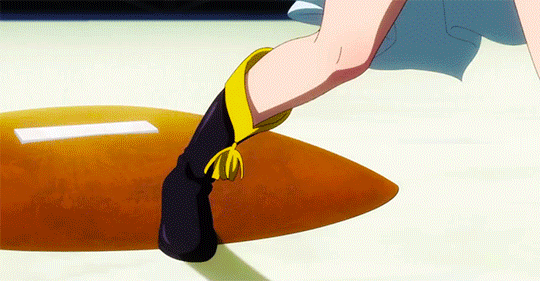
The performers of the revue are divided into two groups, the otokoyaku (男役) who play male roles and the musumeyaku (娘役) who play female roles. Students are trained in these roles from the second year onwards, from which point the otokoyaku cut their hair shorter and adopt masculine forms of speech. Further, within each of the five troupes in a given year, there is a top star - technically two, one otokoyaku, one musumeyaku, but the otokoyaku tends to be heavily prioritised and will be the one referred to the top star - who plays the main character in the performance, and tends to get the lion’s share of devotion and attention.
The Revue covers a great variety of theatre, but a lot of their works are Western, and they are particularly associated with their take on French noble costumes. It was also extensively influential on manga, with Osamu Tezuka growing up very near to Takarazuka. Here, we actually find a bit of a circular chain of influence: the revue influenced the wildly popular shōjo manga The Rose of Versailles, a story indirectly about the Japanese Left but set in the court of Versailles - and notably featuring the fictional Oscar, a woman raised as a boy who becomes captain of the Royal Guard. Takarazuka subsequently staged a number of adaptations of the manga, which became one of their most popular productions and cemented the both the otokoyaku/musumeyaku division and the ‘Top Star’ system in the 70s.
Here’s a poster from the 2013 production:

Naturally, there have been many times when Takarazuka performers have been in lesbian relationships, and sometimes settled down together after leaving the troupe - though this generally must be extremely clandestine since it is grounds for being fired from the Revue. In fact, the militaristic uniforms that became so iconic to the Revue’s image were originally an attempt to curb the rumours of lesbianism; performers were further forbidden from exchanging mail with their fans.
So, Revue Starlight. It is in large part a critique of the Takarazuka Revue - the Top Star system in particular. In addition to their daylight training for a first year production of a story called Starlight, which Emily Rand reads as a blend of The Rose of Versailles and Elizabeth, the girls compete regularly in secret duels on a hidden stage overseen by... a giraffe. The winner of this contest - the one who ‘shines brightest’ and is fit to be Top Star - we eventually learn will be granted the power to make a shine on whatever stage they desire - in effect a pretty open-ended wish. Everyone else? Well, it’s not clear at first... they all really want to be top star.
So, much like Utena, most episodes culminate in a duel, each character armed with a particular weapon. These duels are also occasion for each character to sing a duet, which forms the backdrop to their battle, as the stage contorts itself into symbolism for the relationships being contested. They’re spectacular, thanks in large part to the brilliant action animation of figures like Takushi Koide.
Unlike something like Utena, these hush-hush duels seem to be taking place in a much more mundane world - and though they keep fighting them, the girls also struggle to figure out why exactly there’s a talking giraffe.

Into this charged situation, enter Karen Aijo - who can’t see the logic of the Top Star system and doesn’t see why they can’t all shine on stage, and competes to this end. She’s joined by her childhood friend, Hikari, with whom she shared a promise (yep, it’s anime) to one day perform Starlight with her. And beyond that is a large cast of other ambitious young performers; outside of the duels, the show takes on a kind of tone of lightly comedic, slice of life school story, with enough drama to come out on the secret giraffe stage. (Oh and yeah they’re like... pretty much all gay. It’s fully yuri. How could it not be though really?)
I won’t spoil where it goes, since we’re about to watch it, but it’s a compelling, suitably high-drama arc with some really spectacular animation along the way - and the movie looks like it will be even more so. So, if you will, come and enjoy a delightful opening of what we may hopefully one day call the ‘Ikuhara school’ of symbolism-drenched lesbian anime.
Animation Night 92 will be starting shortly at our usual place - https://twitch.tv/canmom ! We’ll watch the original RevStar series followed by the movie. I’d love to power through it all in one go, but we might end up splitting like we did last week, because it’s not a short programme. Still, for however much we manage tonight, I hope you’ll come join~
24 notes
·
View notes
Text
Fashion Analysis (Part 5: Aromanticism & Fashion?)
[Note: This post is a part of a series analyzing self-expression, fashion, aromanticism, and how they interact with other parts of identity. For full context please read the whole thing!]
Aromanticism and Fashion?
Now that we have gone through LGBTQ+ History with fashion, and the importance of self expression - I think we’re in a good place with all this context to discuss how aromanticism and fashion can intersect. (and again, as a disclaimer, all of this is purely speculative!).
Personally, I think there may be a few philosophies on how Aromanticism and Fashion may interact. You can look at it a few different ways, either considering the influence amatonormativity may have on our methods of dress, but also the context in which Aromantic communities are forming (online).
On the influence of Amatonormativity
Up until this point I’ve been side-stepping the consideration of amatonormativity – but it does impact self-expression, I think, and it’s worth discussing it’s relation to aromanticism.
I had a discussion with one of my aroace friends about the idea of wanting to avoid “attention” in the romantic and/or sexual sense growing up. There is an inherent tie-in with wanting to appear desirable (as shown in the beginning of the comic, and also reinforced through many pieces of popular media), with romantic outcomes. In both of our experiences, I believe it made the idea of being seen as conforming to beauty norms an uncomfortable activity.
And looking back to lesbian fashion history too, we can see this subversion of heteronormative expectation is tied into a lot of their community’s means of dress. Which leads me to wonder - will we also see this with an emerging Aromantic sense of fashion? How could this impact clothing choice, and general expression as it relates to an amatonormative society?
I want to note that personally, outside of professional contexts, I like to dress femininely in a subversive and “alternative” way. I LOVE the idea of being hyperfeminine as a performance, being a living, breathing, work of art, while simultaneously creating an aesthetic that would not consider “attractive” in an amatonormative context. And another aroace friend has confirmed feeling this way with me too! She mentioned she likes to dress in a way that will make women go “wow, we love this outfit” but at the same time cause *conservative straight old men* go “what are you wearing” (to paraphrase our conversation).
I think some good examples of this from my personal experience would be the following:
1. I love aggressive, graphic liner - generally makeup is thought of as something that feminizes the face, something that softens. But I also like to use it to create the angles and shapes that adorn my face, something abstract for the sake of being beautiful. Like mentioned before, I don’t want to appear romantically attractive to anyone, and I think that for me, at least, this is a part of using femininity to subvert these expectations.
2. I love ethereal-looking, avant-garde sheer dresses, not in the sense that they could be romanticized, but in the way they again make me feel detached from the idea of beauty for the sake of appealing to anyone else. Instead, for me it feels like beauty as a wild, untameable form of nature and being.
But … maybe I should mention the unconventional tastes are partially tied to the fact I spend a lot of time in creative spaces because of my degree, and overall I am exposed to more diverse ranges of self-expression to begin with! Either way, though, I am curious what other aros have to say, so feel free to let me know your experiences with this. I’d love to provide an update with thoughts from other aros!
Forming Community Online and its Possible Impacts
The online nature of the development of Aro Culture leads me to wonder if this medium of interaction will influence the development of our fashion, much like how it influences the development of fashion overall. For example, with tiktok, the app is often credited for its major influence on modern fashion trends (and leading to the emergence of microtrends).
Most visual designs are being affected by the way social media algorithms work too. The “allegria style” created by facebook, otherwise known as the “flat gangly limbed drawing style beloved by tech companies”, has exploded in popularity. Regardless of how one might feel about the widespread adoption of this style of illustration, it’s clear that it has significant advantages that have led to its popularity, one of which is its ability to be “consumed” or visually understood at high speed due to its graphic nature and simple design. Basically, when people look at things on their phones, and they’re scrolling quickly, they’re more likely to understand what they see and interact with what they see if it’s easy to visually “read”. And I truly believe that this is influencing most forms of design, including fashion (which subsequently, will influence aro fashion). If you’d like to learn more about this subject, sources 14, 15, and 16 provide more insight into how social media algorithms have influenced design and visual culture at large.
I think another factor to consider here is the effect of seeing the whole world at once - having the influence of all different media, visuals, and pop culture at the same time has created a very unique environment for development. As one example, the wider aspec communities have developed with the existence of our flags (which are purple and green centered for ace and aro respectively). This would be knowledge that wouldn’t be so easily spread through the whole community in a pre-internet era, and I personally (THIS IS ONLY MY THEORY) feel this is part of the reason there is a far stronger connection to these colours within aspec culture. It’s something that unifies us and was one of our first introductions to the community (since most of us probably looked up the definition of aromantic, or asexual, online), and I think for this reason these colours hold special significance and are present in a lot of of our means of self expression and communication with other members of our community.
Obviously, the formation of symbols and ways of self-identification will occur anyway (many symbols exist for other members of the LGBTQ+ community too), but I do think being online has a particular influence on the ways community symbols are communicated, and create a different context in where these cultural symbols take shape.
[Note from Author: For Part 6, click here!]
37 notes
·
View notes